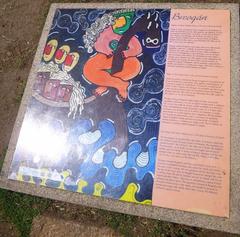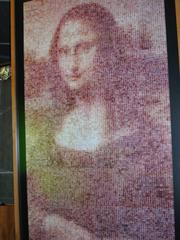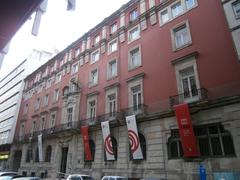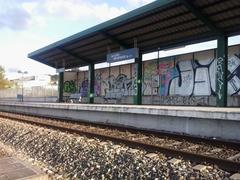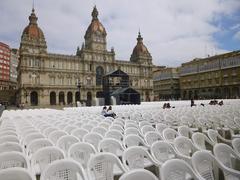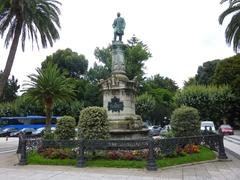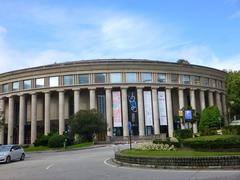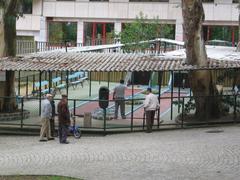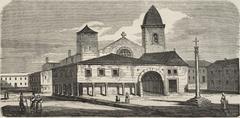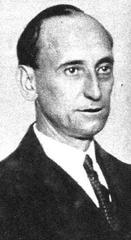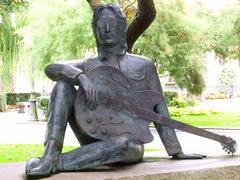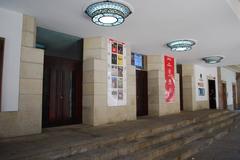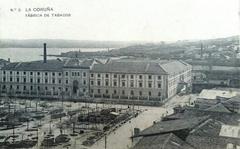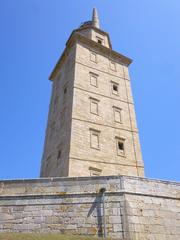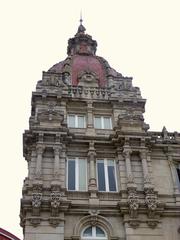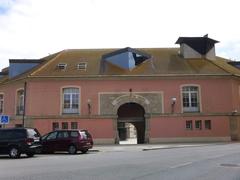Castro de Elviña: Visiting Hours, Tickets, and Historical Information in A Coruña, Spain
Date: 14/06/2025
Introduction: Discovering Castro de Elviña
Castro de Elviña, perched on a commanding hill in the Elviña parish of A Coruña, Galicia, is a cornerstone of northwestern Iberia’s archaeological heritage. Established in the 3rd century BCE by the Celtic Gallaeci tribes, this remarkable castro presents an exceptional testament to Iron Age ingenuity and its subsequent transformation under Roman influence. Its concentric defensive walls, sophisticated urban planning, and ritual spaces narrate a story of cultural evolution, resilience, and adaptation.
Over centuries, Castro de Elviña transitioned from a vibrant Celtic settlement to a Romanized hub, as evidenced by its changing architecture, material culture, and religious artifacts. Although abandoned by the late 4th century CE, systematic archaeological exploration since the 19th century has revitalized its significance. Today, the site stands as a living cultural and research hub, welcoming visitors with free admission, guided tours, and educational programs, while ongoing conservation efforts safeguard its legacy for future generations (Spotting History, ArqueoLugares, La Voz de Galicia).
Content Overview
- Historical Background and Cultural Significance
- Archaeological Features and Material Culture
- Conservation and Restoration Initiatives
- Ongoing Research and Academic Integration
- Visiting Information: Hours, Tickets, Accessibility, and Directions
- Special Events, Educational Programs, and Nearby Attractions
- Photographic Opportunities and Travel Tips
- Frequently Asked Questions (FAQ)
- Summary and References
Historical Background
Origins and Early Settlement
Founded around the 3rd century BCE, Castro de Elviña was part of a widespread network of hillforts (castros) in Galicia. Its strategic hilltop location provided both defense and broad visibility across the surrounding valleys. Early inhabitants built circular and oval stone dwellings, enclosed by formidable walls and earthworks—hallmarks of the Castro culture (Spotting History).
Roman Influence and Transformation
Roman expansion in the 1st century BCE brought architectural innovation and new cultural practices. The settlement incorporated rectangular Roman-style buildings and adopted imported ceramics and metalwork. Despite this Romanization, indigenous traditions persisted, creating a unique blend of local and imperial customs (ArqueoLugares).
Decline, Abandonment, and Rediscovery
By the late 4th century CE, the castro’s population dwindled as new urban centers emerged. Rediscovered in the 19th and 20th centuries, the site has since undergone extensive archaeological research, revealing its layered history and broader connections within Galicia (Digital CSIC).
Archaeological Features and Material Culture
Defensive Architecture and Urban Layout
Covering over 4 hectares, Castro de Elviña is encircled by three concentric granite walls, demonstrating advanced military engineering. The innermost citadel, or croa, features the densest concentration of dwellings and communal spaces, while intermediate terraces contain additional homes and workshops. Entrances were designed for defense, with narrow access points and interconnected terraces.
Domestic and Ritual Structures
Excavations have uncovered clusters of circular stone huts, larger communal buildings, and specialized ritual spaces such as the “Edificio de los Betilos,” a cultic structure identified with pre-Roman spiritual practices. The sophisticated Fuente-Aljibe (cistern) highlights the community’s water management expertise.
Artifacts and Economic Life
- Ceramics: Predominantly local, with a small but significant presence of Mediterranean amphorae indicating trade links.
- Metalwork: Finds include iron tools, bronze ornaments, and evidence of local production.
- Gold Hoards: The Tesoro de Elviña, a collection of gold jewelry, underscores the settlement’s prosperity and craftsmanship.
- Ritual Objects: Sacred stones (betyls) and other cultic artifacts illustrate the community’s spiritual complexity.
Conservation, Restoration, and Site Enhancement
Protective Measures
A transparent, reversible perimeter fence has been installed to minimize impact on the landscape while safeguarding unexplored areas. Removal of non-native eucalyptus trees is underway to restore the castro’s visibility and ecological balance (La Voz de Galicia).
Restoration and Accessibility Initiatives
Recent efforts include stabilizing original structures, particularly the monumental southwest entrance, and planning a support building for educational and visitor services. Accessibility projects, such as improved pathways and electric vehicle options, aim to make the site more inclusive.
Site Maintenance
A dedicated multi-year maintenance contract ensures regular vegetation control, path upkeep, and monitoring of structural integrity, aligning with sustainability principles and reversible interventions (La Voz de Galicia).
Ongoing Research and Academic Integration
Castro de Elviña is a focal point for archaeological research, with annual fieldwork involving university students and professionals. Excavations have revealed proto-urban planning, craft production areas, and ritual spaces, enriching academic understanding and fostering stewardship among new generations (La Voz de Galicia).
Artifacts are curated at the Museo Arqueolóxico del Castillo de San Antón, where dedicated exhibits make research accessible to the public (Digital CSIC).
Visitor Information
Opening Hours
- Summer (April–September): 10:00 AM – 7:00 PM
- Winter (October–March): 10:00 AM – 5:00 PM
- Note: Hours may vary seasonally or due to special events; always check the official A Coruña tourism website before visiting.
Tickets and Admission
- Admission: Free for all visitors.
- Guided Tours: Offered mainly on weekends and by reservation. Tours provide expert insights and access to restricted areas. Advance booking is recommended via the Museo Arqueolóxico de San Antón or the official tourism website.
Accessibility
- Upgraded pathways and planned electric vehicles improve access for those with reduced mobility.
- Some uneven terrain remains; comfortable footwear is strongly advised.
- Contact the visitor center ahead of your visit for specific accessibility needs.
Directions and Parking
- Located just a few kilometers from central A Coruña.
- Reachable by car (parking available nearby) or public transport (local bus routes from city center).
Special Events, Educational Programs, and Nearby Attractions
- Special Events: The castro hosts open-air theater, cultural festivals, and archaeological workshops, especially in spring and summer.
- Educational Programs: School visits and intergenerational exchanges are core to the site’s mission.
- Nearby Attractions: Combine your visit with the Tower of Hercules, Museo Arqueolóxico del Castillo de San Antón, and A Coruña’s historic old town for a comprehensive cultural itinerary.
Travel Tips and Photographic Highlights
- Best Time to Visit: Spring and early autumn for mild weather and fewer crowds.
- What to Bring: Water, sun protection, and a camera.
- Photo Spots: Panoramic hilltop views, monumental entrance, and reconstructed dwellings.
Frequently Asked Questions (FAQ)
Q: What are the visiting hours for Castro de Elviña?
A: Typically 10:00 AM – 7:00 PM (summer), 10:00 AM – 5:00 PM (winter). Confirm on the official website.
Q: Is there an entrance fee?
A: No, entry is free.
Q: Are guided tours available?
A: Yes, mainly on weekends and by reservation. Check with the Museo Arqueolóxico de San Antón.
Q: Is the site accessible for visitors with mobility issues?
A: Ongoing improvements are making the site more accessible. Contact ahead for details.
Q: How do I get there?
A: By car or public bus from A Coruña; parking is available near the site.
Conservation and Future Directions
Preservation of Castro de Elviña is guided by sustainability and adaptability, with reversible interventions, regular maintenance, and careful planning for future musealization. Plans for an archaeological park and visitor center are under discussion, aiming to further integrate the site into A Coruña’s vibrant cultural life (La Voz de Galicia).
Summary and Encouragement to Explore
Castro de Elviña is an essential destination for understanding the roots of Galician culture. Its meticulously preserved defenses, diverse architecture, and rich artifact collections offer a window into the ancient world. With free admission, accessible guided tours, and a growing suite of visitor amenities, the castro is at the forefront of heritage tourism in A Coruña.
Visitors are encouraged to explore the site, participate in educational programs, and support ongoing conservation. Download the Audiala app for curated tours and the latest updates, and consult the official tourism platforms for event schedules and travel tips.
Visuals & Media
Images and interactive maps are recommended for inclusion, showing the panoramic views, defensive walls, and reconstructed dwellings of Castro de Elviña.
References
- Spotting History: Castro de Elviña
- ArqueoLugares: Castro de Elviña, Coruña, Galicia Archaeological Information
- La Voz de Galicia: Castro de Elviña Conservation and Research Updates
- Digital CSIC: Archaeological Research and Reconstruction Proposals
- Official A Coruña Tourism Website


